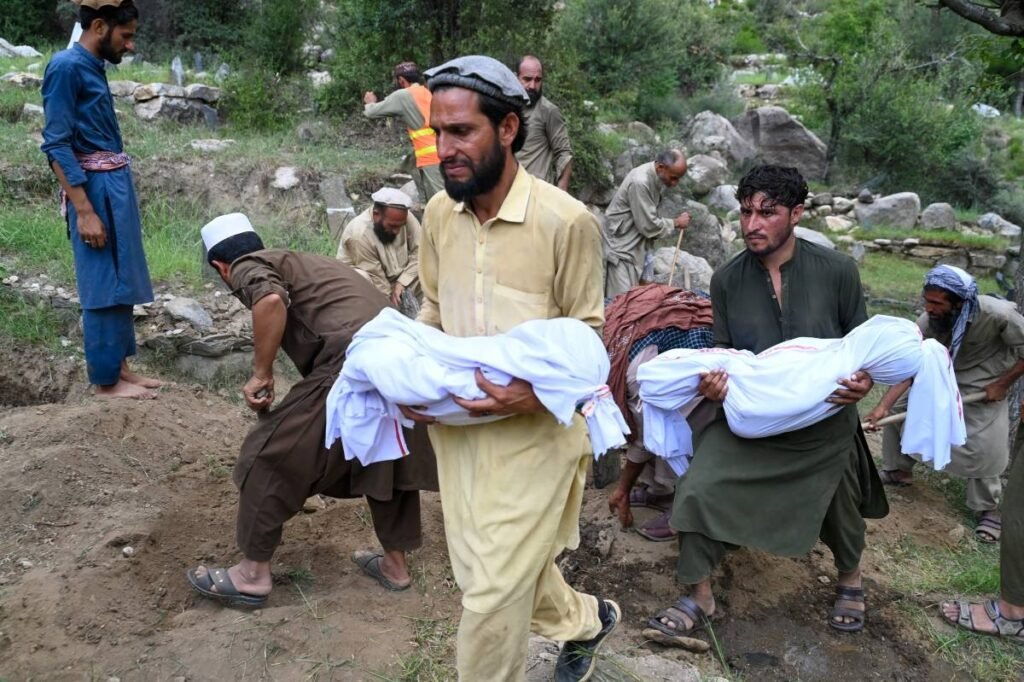A powerful magnitude 6.0 earthquake struck eastern Afghanistan’s mountainous border region late on 31 August 2025, killing more than 1,400 people and injuring over 3,000, officials said, as rescuers raced against time to reach isolated villages.

The quake devastated mud-brick villages across Kunar, Nangarhar, and neighboring provinces, flattening whole communities at night and producing a humanitarian emergency in a country already weakened by years of conflict, sanctions, and a reduced international aid footprint. Getting lifesaving aid into blocked mountain valleys is now the urgent priority—and the biggest logistical challenge.
The scale of destruction and the human toll
Taliban government spokesman Zabihullah Mujahid posted casualty figures that put the dead above 1,400 and the injured at more than 3,000, warning the total was likely to rise as rescuers reached more remote hamlets. Local hospital officials and health workers described dozens of bodies arriving at overwhelmed clinics and many more people still buried beneath rubble. The U.S. Geological Survey recorded the quake as a 6.0-magnitude event with shallow depth, which amplified surface shaking.
Rescue efforts hampered by terrain, weather, and damaged roads
Search-and-rescue teams—including local volunteers, Afghan Red Crescent workers, and Taliban commandos—have been working around the clock. But officials say heavy rain, steep mountain roads, and washed-away bridges have severely restricted access, forcing many communities to rely initially on improvised local efforts to pull survivors from collapsed homes. Helicopter lifts have helped move some of the critically injured to regional hospitals, but the scale of displacement and ruined infrastructure complicates a rapid response.

Aid trickles in amid diplomatic and operational constraints.
Despite a flurry of international expressions of sympathy, deliveries of large-scale relief supplies have been modest and often routed through international agencies rather than directly to the Taliban administration. UNICEF, the IFRC, and partner NGOs reported sending medical supplies, tents, sanitation kits, and emergency clothing, while some countries—including the UK, UAE, and India—pledged or dispatched assistance through UN or Red Cross channels. Observers say frozen Afghan government assets and concerns about routing aid under Taliban control are slowing a faster, larger response.
On-the-ground needs—shelter, trauma care, and winter risk
Relief agencies warn of acute needs: shelter for thousands of displaced people, trauma and surgical care for the wounded, clean water and sanitation to prevent disease outbreaks, and winter preparedness as cold weather approaches. The IFRC and Afghan Red Crescent emphasized the need for tents, blankets, and fuel, while health partners called for surgical teams and blood supplies to treat crush injuries and shock victims.
Rapid escalation of figures
The earthquake struck just before midnight local time on August 31; initial official counts reported several hundred dead, but as roads cleared and teams reached more villages, the tally rose—first into the hundreds and then past 1,400. Multiple aftershocks were reported, complicating rescue operations. This is one of the deadliest earthquakes to hit Afghanistan in recent decades and follows a pattern of vulnerability where seismic shocks disproportionately harm communities living in mud-brick houses.

Immediate Priorities (Next 72 Hours)
- Coordinated Aid Delivery – Establish delivery channels ensuring aid reaches civilians while respecting international legal and operational constraints.
- Medical Evacuations & Surgical Teams – Scale up air and ground evacuations while deploying specialized medical and surgical units to critical areas.
- Emergency Shelter & WASH Supplies – Distribute tents, blankets, water purification kits, and sanitation support to displaced families.
- Access to Remote Areas – Clear blocked mountain roads or arrange airlifts to reach communities cut off by landslides and terrain.
Attribution & sources
According to Taliban government statements and field reporting compiled by major news agencies, the earthquake in eastern Afghanistan has killed more than 1,400 people and injured over 3,000, with rescue operations underway amid severe access problems. Reporting and situation updates used for this article include on-the-ground coverage by The Associated Press, Reuters, The Guardian, Al Jazeera, and humanitarian briefings from the IFRC and UN agencies. Key seismic data are from the USGS.
Conclusion
The human toll and destruction from the eastern Afghanistan quake are still unfolding. The combination of nighttime shaking, fragile housing, and difficult geography has turned a single seismic event into a major humanitarian crisis. Rapid, well-coordinated international support—delivered in ways that reach civilians on the ground—is essential to save lives and prevent a secondary public-health emergency as damaged communities face cold weather and limited medical capacity.











